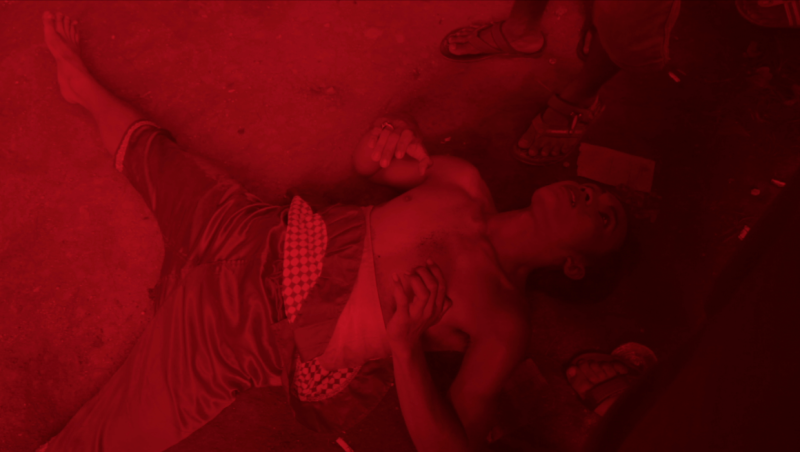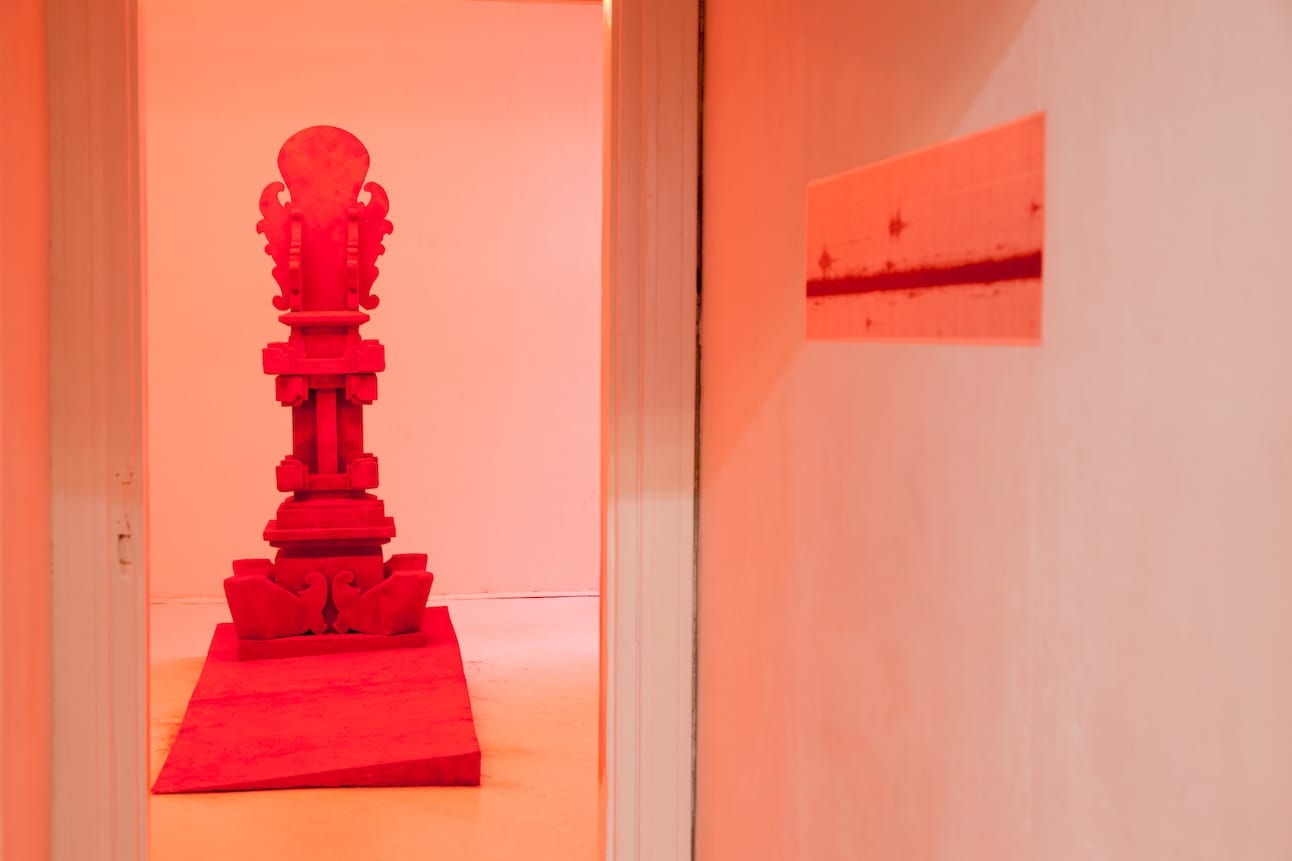Justyna Górowska
Dziewczyna, która poślubiła wulkan
kuratorka: Zuzanna Derlacz
Tytuł wystawy zaczerpnięty został z jednej z prezentowanych prac Justyny Górowskiej, choć nie odnosi się wyłącznie do tego projektu – tytułową „dziewczyną, która poślubiła wulkan” może być zarówno sama artystka, jak i każdy, kto podejmie próbę zrozumienia jej postawy. Ceremonia zaślubin z duchem wulkanu, z którą Górowska zetknęła w Indonezji, pełni tu funkcję metafory przejścia, umożliwiającego wniknięcie w nierozpoznany porządek i poddanie się panującym w nim regułom. Tytuł ten sygnalizuje obecne w pracach artystki próby przekraczania przyjętych granic, a nawet poddawania w wątpliwość możliwości wyraźnego rozgraniczenia między widzialnym a niewidzialnym, ludzkim a nie-ludzkim oraz przede wszystkim między kulturą a naturą.
W przypadku projektu Merapi (2013), podobnie jak w innych pracach Górowskiej powstałych w Indonezji, punktem wyjścia są endemiczne wierzenia oraz wynikający z nich nieesencjalistyczny światopogląd, w zetknięciu z którym kluczowe dla zachodniej kultury wyobrażenia określające kondycję człowieka wystawiane są na próbę. Podczas pobytu w niewielkiej wiosce położonej na zboczu aktywnego wulkanu Merapi, artystka usłyszała o ceremonii zaślubin lokalnej dziewczyny z duchem wulkanu, zwanym Petruk, co skłoniło ją do przyjrzenia się bliżej jawajskiemu mistycyzmowi i związanym z nim praktykom. Merapi jest reinterpretacją tego rytuału, plasującą to wydarzenie w szerszym kontekście poprzez ukazanie człowieka, który nie boi się wyrzec swojej autonomii, a więc który rezygnuje z antropocentrycznej optyki umiejscawiającej go w centrum wszechświata. Dodatkowym aspektem projektu była konfrontacja dwóch pozornie wykluczających się sposobów pojmowania rzeczywistości, podejścia magicznego oraz podejścia naukowego. Artystka udała się do pobliskiej stacji badawczej, gdzie uzyskała wykres sejsmograficzny wskazujący na wzmożoną aktywność wulkanu w czasie trwania ceremonii zaślubin.
Następny powstały w Indonezji projekt koncentruje się na postaci orang pendeka, legendarnego hominida, pół człowieka, pół zwierzęcia, zamieszkującego według świadków lasy Sumatry. Kim lub czym jest orang pendek? Czy naprawdę istnieje? Takie pytania zadawali sobie Justyna Górowska i Adam Gruba przed udaniem się w głąb lasu w poszukiwaniu stworzenia mogącego być „utraconym ogniwem ewolucji”, ale które, będąc nieuchwytnym dla naukowców, jest zaledwie ciekawostką w obrębie kryptozoologii. Jednak to, co dla świata nauki pozostaje niewidzialne i nieudowodnione, a więc nieistniejące, jest wystarczająco realne dla mieszkańców Sumatry, dla których hominid przekracza sferę legend i opowieści, choć, jak słyszymy w wideo orang pendek (2013), „widzieli go tylko ci, którzy mają dużo szczęścia”. W miarę zagłębiania się w mglistą sumaryjską dżunglę wyostrzają się nie tylko zmysły, ale i wyobraźnia, a granice między kategoriami widzialności i niewidzialności, istnienia i nieistnienia, ludzkiego i nie-ludzkiego stopniowo ulegają rozmyciu. Głównym pytaniem nie jest już „czy istnieje?”, lecz „co sprawia, że może istnieć?”.
FoxP2 (2012) to kolejna prezentowana na wystawie praca poddająca w wątpliwość zasadność przeciwstawiana sobie wspomnianych wcześniej kategorii i skupiająca się na języku jako na najmocniejszym wyrazicielu, a nawet twórcy tych kategorycznych rozgraniczeń. Górowska po przejściu kursu inżynierii genetycznej na Wydziale Biotechnologii Uniwersytetu Rolniczego w Krakowie wyizolowała fragment swojego DNA w postaci genu FoxP2, potocznie zwanego genem komunikacji. Choć gen ten występuje także u innych zwierząt, tylko jego ludzka wersja umożliwia komunikację za pomocą mowy, co oznacza, że jedną z najbardziej wyróżniających nas cech zawdzięczamy drobnej mutacji białka. Częścią instalacji jest wyizolowany przez artystkę gen, umieszczony w specjalnym pojemniku i otoczony lustrami, które jeszcze bardziej go odrealniają. Towarzyszy mu wideo, w którym Górowska odtwarza scenę tresury jedynie za pomocą wyrwanych z jej kontekstu brutalnych słów, wypowiadanych w nieadekwatnie łagodny sposób. Uwaga skupiona jest nie na pozostającym w sferze domysłu zwierzęciu, lecz na człowieku, który obejmuje nad nim panowanie za pomocą i ze względu na język.
Widoczne w orang pendeku i FoxP2 wątki relacji międzygatunkowych oraz refleksje nad klasyfikacją i hierarchią gatunków po raz pierwszy pojawiły się w pracach Górowskiej już parę lat wcześniej, m.in. w wideo Iris i Reks (2009), w którym artystka przedstawia silną emocjonalną relację łączącą ją z jej psami w czułej, zmysłowej scenie, której szczególny charakter podkreślony jest towarzyszącą jej muzyką. Równie duże znaczenie ma muzyka w wideo Zabiłeś za mnie kurę (2011), gdzie agonia kury zostaje zestawiona z utworem Czajkowskiego, który podporządkowuje sobie obraz ostatnich chwil zwierzęcia – tym sposobem „kultura” zawłaszcza „naturę”. Kura zaprezentowana zostaje również w postaci szkieletu zakończonego estetyzującym obiekt piórem.
Na wystawie pokazywana jest również praca FW JG (od 2009), nagrodzona w 2010 roku główną nagrodą Samsung Art Master. W tym projekcie Górowska, kontynuując podejmowane w swoich wczesnych pracach gry z tożsamością, wciela się w zmarłą śmiercią samobójczą w wieku 22 lat amerykańską fotografkę Francescę Woodman poprzez odtwarzanie jej zdjęć w postaci jednominutowych dokamerowych performansów, dzięki którym nawiązuje szczególną relację z autorką pierwowzorów.
Justyna Górowska (ur. 1988) – absolwentka Wydziału Intermediów Akademii Sztuk Pięknych w Krakowie. Zajmuje się performansem, wideo, rzeźbą i fotografią. Laureatka głównej nagrody VII edycji konkursu Samsung Art Master (2010) oraz Grand Prix III Festiwalu Sztuki Młodych „Przeciąg” w Szczecinie (2011). Jej prace były prezentowane m.in. w Centrum Sztuki Współczesnej Zamek Ujazdowski w Warszawie (2010, 2014), w Centrum Rzeźby Polskiej w Orońsku (2011) oraz na Festiwalu „Inspiracje” w Szczecinie (2012, 2014), a także na międzynarodowych wystawach i festiwalach artystycznych, m.in. we Freies Museum w Berlinie (2009), w Barbur Gallery w Jerozolimie (2010), w Muzeum Leonarda da Vinci w Mediolanie czy podczas International Performance Festival „RIAP” w Quebecu (2014). W latach 2010/2011 oraz 2012/2013 stypendystka Ministra Kultury i Dziedzictwa Narodowego. W 2014 roku otrzymała Nagrodę Ministra Kultury i Dziedzictwa Narodowego. Od 2014 roku współpracuje z lokalem_30.
______________
Justyna Górowska
The Girl who Married a Volcano
curator: Zuzanna Derlacz
The title of the exhibition has been borrowed from one of the presented works by Justyna Górowska. Yet, it certainly has a broader array of references – the eponymous “girl who married a volcano” can refer both to the artist herself and to everyone who explores her artistic approach. Górowska uses a ceremonial wedding with the spirit of a volcano, a ritual encountered in Indonesia, as a metaphor of a rite of passage that gives us access to an unknown order and an opportunity to function according to its rules. Not only is the title indicative of the artist’s attempts to transgress established borders, but it also expresses a challenge to clear-cut distinctions between the visible and the invisible, the human and the non-human, and above all, between culture and nature.
Akin to Górowska’s other works from Indonesia, local beliefs and their implied non-essentialist world view underpin the project Merapi (2013). This world view challenges some of the key concepts that define the human condition in Western culture. In a small village on a slope of the active volcano Merapi Górowska was told about a peculiar wedding ceremony when a local girl married the spirit of the volcano, called Petruk. This story inspired her to explore the mysticism and mystical practices of Java. Merapi is a reinterpretation of the ritual. The ceremony appears in a broader context – the work features a person who is not afraid to resign from autonomy in order to become an integral element of reality; a person who rejects the anthropocentric perspective and the claim that humans are the centre of the universe. Another aspect of the project is a confrontation between two seemingly opposing ways of understanding reality: through magic and through science. This aspect is brought to the fore by the artist’s enquiry in a nearby seismograph station, which reveals an increase in the seismic activity of the volcano during the wedding ceremony.
The next work from Indonesia revolves around the figure of orang pendek, a legendary hominid – half-man, half-animal – that inhabits the forests of Sumatra, according to eye witness reports. Who or what is orang pendek? Does it really exist? Those questions occupied the minds of Justyna Górowska and Adam Gruba during their exploration of the forest in search of the creature that can potentially be “the missing link of the evolution chain”. Unrecognised by science, the same creature remains merely one of the curiosities of cryptozoology. Yet, what academia considers as unrecognised and unproven – and therefore non-existent – is real enough for the people of Sumatra. For the local communities the hominid is more than a legend, even though, as we are told in the video orang pendek (2013), “it requires a lot of luck to come across the creature.” As we go deeper into the misty jungle of Sumatra, not only our senses become more acute but also our imagination. The borders between the categories of visibility and invisibility, existence and non-existence, the human and the non-human, are gradually blurred. The main question is no longer: “does it exist?”, but „what can allow it to exist?”
FoxP2 (2012) is another work that questions the opposition between the previously discussed categories. It also focuses on language as the strongest expression, or even the creative force behind the oppositions that exist between categories. After completing a course in genetic engineering at the Faculty of Biotechnology of the University of Agriculture in Cracow, Górowska isolated a fragment of her own DNA: the FoxP2 gene, commonly known as the gene responsible for communication. Even though the gene is found also in animals, only the human variety can guarantee the ability to communicate through speech. This means that one of the most distinctive features of our species results from a slight mutation in the proteins. The gene that the artist isolated is featured in a special container and surrounded by mirrors, which lend an even more surreal mood to the work. The installation is accompanied by Górowska’s video of animal training procedures that the artist re-enacts only by means of harsh and brutal words extracted from their original context. Creating a dissonance, the words are spoken in a gentle manner. The focus is not on the animal, which never appears in the film, but on the human being – language is both the tool and the source of legitimacy of the human pursuit of control over other animals.
Featured in orang pendek and FoxP2, the links between species and questions about their classification and hierarchy informed Górowska’s works already several years earlier, for instance in the video Iris and Reks from 2009, where the artist portrays in a tender and sensual scene – with music that highlights its special character – the strong emotional bonds that she has developed with her dogs. The score plays an important role also in the video You Killed a Hen for Me from 2011, where the soundtrack to the eponymous scene is a composition by Tchaikovsky. The music dominates the footage of the final moments of the animal’s life. Thus, “culture” conquers “nature”. The hen is present also as a skeleton crowned with a feather that lends an aesthetic appeal to the object.
The exhibition includes the work FW JG (since 2009), awarded the main prize of the competition Samsung Art Master in 2010. In the project Górowska returns to the games that she played with identity in her earlier works. She appears as the American photographer Francesca Woodman, who committed suicide at the age of 22, and re-enacts her photographs through one-minute camera performances. This method allows her to establish a special kind of connection with the American creator of the original images.
Justyna Górowska (b. 1988) – graduate of the Faculty of Intermedia at the Academy of Fine Arts in Cracow. Górowska is a performance and video artist, a sculptor and a photographer. Awarded the main prize of the 7th Samsung Art Master competition (2010), and the Grand Prix of the 3rd Festival of Young Art “Przeciąg” in Szczecin (2011). Her works have been presented at the Centre for Contemporary Art Ujazdowski Castle in Warsaw (2010, 2014), the Centre of Polish Sculpture in Orońsko (2011), the Freies Museum in Berlin (2009), the Barbur Gallery in Jerusalem (2010), and the Leonardo da Vinci Museum in Milan (2011). She has also participated in many international festivals, such as the the “Inspirations” Festival in Szczecin (2012, 2014) and the International Performance Festival “RIAP” in Quebec (2014). In 2010/2011 and 2012/2013 she received a scholarship from the Minister of Culture and National Heritage. In 2014 she was awarded by the Minister of Culture and National Heritage. As of 2014, Górowska is represented by lokal_30.



















